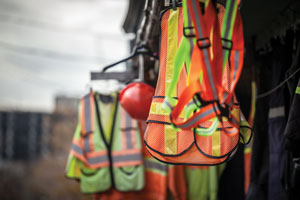How to reduce injury risk for new hires
 |
The Bureau of Labor Statistics reports almost one-third of nonfatal workplace injuries involve employees who have been employed for less than one year, according to Safety+Health magazine. Nearly 25% of these injuries result in more than one month of lost work time.
The first 90 days reportedly are the most dangerous for new hires because they may lack some of the knowledge needed to avoid getting injured on job sites. New hires also may be unfamiliar with risk assessments, less comfortable using personal protective equipment and/or unsure of who to approach with questions about safety.
In Safety+Health magazine, Larry Pearlman, senior safety consultant for SafeStart, Belleville, Ontario, offers steps employers can take to keep new hires safe.
- Use a green hat and/or vest to visually identify new hires. This invites co-workers to help coach, mentor and intervene and can help accelerate learning.
- New hires must receive a safety orientation on their first days, allowing safety professionals to take time to discuss the practical realities of the job site with new workers.
- Ask experienced employees to share their insights and meet with new hires to set expectations, share personal stories and emphasize the need to build a strong safety culture.
- Be sure it is clear to new workers how stop-work authority can be exercised, including who they should talk to and how they can raise safety concerns, to avoid fear of reprisal.
- Ensure team leaders connect and engage with new hires. Leaders should make sure new hires familiarize themselves with the names of their leaders and know their well-being is valued.
Cold, wet conditions affect self-retracting lifelines
When working properly, self-retracting lifelines can detect a sudden increase in speed—such as a fall—and a locking mechanism activates and stops the fall, according to the Ontario Ministry of Labour, Immigration, Training and Skills Development.
However, cold and wet environmental conditions can cause the locking mechanism to seize, resulting in the cable continuing to spool out and the lifeline not stopping the fall.
Safety+Health magazine offers tips for preventing this hazard:
- Rapidly pull the cable to verify the components of the locking mechanism are working properly. Do this before the self-retracting lifeline is used for any task and also throughout the day.
- Pull out the cable to ensure the locking mechanism inside the housing responds to a sudden tug on the cable. It should lock up as a seat belt does when a car comes to a sudden halt.
- If wet, self-retracting lifelines should be stored vertically to dry.
Workers should notify supervisors immediately and refrain from using a self-retracting lifeline if the locking mechanism is not working.
DOL awards $12.7 million in grants for workplace safety
The Department of Labor has announced the Occupational Safety and Health Administration has awarded $12.7 million in grants to 100 nonprofit organizations to support education and training to help workers and employers recognize serious workplace hazards, employ injury prevention, and understand workers’ rights and employers’ responsibilities under federal law.
Funded through the Susan Harwood Training Grant Program, the grants will be awarded in three categories: Capacity Building, Targeted Topic Training, and Training and Educational Materials Development. OSHA awards grants to nonprofit organizations, employer associations, labor unions, joint labor-management associations, Native American tribes, and local and state-sponsored colleges and universities; target trainees include small-business employers and underserved vulnerable workers in high-hazard industries.
“These grants are one of our most effective resources for providing training and education to hard-to-reach workers in high-hazard injuries,” says Doug Parker, assistant security of labor for Occupational Safety and Health. “Training should be a key part of ensuring vulnerable workers are in safe and healthy environments and that they feel safe at work.”
A full list of Susan Harwood Training Grant recipients is available at osha.gov/news/newsreleases.



